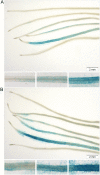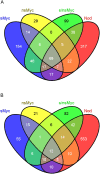Transcriptional responses toward diffusible signals from symbiotic microbes reveal MtNFP- and MtDMI3-dependent reprogramming of host gene expression by arbuscular mycorrhizal fungal lipochitooligosaccharides
- PMID: 22652128
- PMCID: PMC3425205
- DOI: 10.1104/pp.112.195990
Transcriptional responses toward diffusible signals from symbiotic microbes reveal MtNFP- and MtDMI3-dependent reprogramming of host gene expression by arbuscular mycorrhizal fungal lipochitooligosaccharides
Abstract
The formation of root nodules and arbuscular mycorrhizal (AM) roots is controlled by a common signaling pathway including the calcium/calmodulin-dependent kinase Doesn't Make Infection3 (DMI3). While nodule initiation by lipochitooligosaccharide (LCO) Nod factors is well characterized, diffusible AM fungal signals were only recently identified as sulfated and nonsulfated LCOs. Irrespective of different outcomes, the perception of symbiotic LCOs in Medicago truncatula is mediated by the LysM receptor kinase M. truncatula Nod factor perception (MtNFP). To shed light on transcriptional responses toward symbiotic LCOs and their dependence on MtNFP and Ca(2+) signaling, we performed genome-wide expression studies of wild-type, Nod-factor-perception mutant1, and dmi3 mutant roots challenged with Myc- and Nod-LCOs. We show that Myc-LCOs lead to transient, quick responses in the wild type, whereas Nod-LCOs require prolonged incubation for maximal expression activation. While Nod-LCOs are most efficient for an induction of persistent transcriptional changes, sulfated Myc-LCOs are less active, and nonsulfated Myc-LCOs display the lowest capacity to activate and sustain expression. Although all symbiotic LCOs up-regulated a common set of genes, discrete subsets were induced by individual LCOs, suggesting common and specific functions for these in presymbiotic signaling. Surprisingly, even sulfated fungal Myc-LCOs and Sinorhizobium meliloti Nod-LCOs, having very similar structures, each elicited discrete subsets of genes, while a mixture of both Myc-LCOs activated responses deviating from those induced by single treatments. Focusing on the precontact phase, we identified signaling-related and transcription factor genes specifically up-regulated by Myc-LCOs. Comparative gene expression studies in symbiotic mutants demonstrated that transcriptional reprogramming by AM fungal LCOs strictly depends on MtNFP and largely requires MtDMI3.
Figures








References
-
- Akiyama K, Matsuzaki K, Hayashi H. (2005) Plant sesquiterpenes induce hyphal branching in arbuscular mycorrhizal fungi. Nature 435: 824–827 - PubMed
-
- Arnon DI, Hoagland DR. (1940) Crop production in artificial culture solutions and in soils with special reference to factors influencing yields and absorption of inorganic nutrients. Soil Sci 50: 463–483
-
- Arrighi JF, Barre A, Ben Amor B, Bersoult A, Soriano LC, Mirabella R, de Carvalho-Niebel F, Journet EP, Ghérardi M, Huguet T, et al. (2006) The Medicago truncatula lysin [corrected] motif-receptor-like kinase gene family includes NFP and new nodule-expressed genes. Plant Physiol 142: 265–279 - PMC - PubMed
Publication types
MeSH terms
Substances
Associated data
- Actions
LinkOut - more resources
Full Text Sources
Molecular Biology Databases
Miscellaneous

